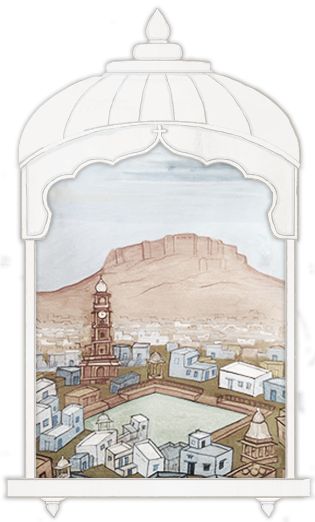Diverse Water Spaces
Historically people who resided in hot, desert regions have created various types of large-scale water reservoirs for storing and accessing water. Depending upon spatial characteristics and intended public, personal or community use, the water reservoirs had different designs. This story captures the diversity of the water bodies and structures which exist in the vicinity of Mehrangarh Fort.
Jhalra
Jhalra is a form of a subterranean structure, usually constructed in a space where water is filled up through cracks and fissures in the stone terrain underneath. The depth of Jhalra is higher as compared to its width or length. Jhalra has a flight of steps on its three edges leading to the level of water and the fourth edge usually has a verandah or Persian wheel to draw water. It is an excellent example of stone construction and engineering, the steps are a scaling device where each flight correlates approximately to the height of the human shoulder.
Sar
Sar means Lake also known as Talab/Nadi/Sagar/Samand/Bandh/Kund. These are formed when a part of the catchment area or a part of the valley is enclosed with structural embankments, following the concept of dams. Depending upon the function of the dam superstructure, the reservoirs were termed Nadi, Talab, Sagar, Sar, Sambandh, or Bandh.
Larger reservoirs with a large catchment were termed Sagar or Samand while the smaller ones were called Kund and Talab. Nadi were reservoirs from the rural areas, whereas Bandhs were found in old, as well as, newly developed cities. Sar is the reservoir mostly found in the narrow catchments of dense cities.
Sagar
Sagar refers to a tank. The term defines an enclosed built containment. In Jodhpur, the tanks were constructed to harvest water from the catchment areas within the city. The main connections of these tanks to lakes are different-sized canals. These tanks are referred to as Sagar in the vernacular language. The edges of these tanks consist of platforms and ghats-like steps.
Bawdi
Bawdis were earlier constructed with a basic stone masonry and were dug according to the need for water. It was much later that stones were carved out from huge stone blocks by Shilpi / Karigar (Stone Craftsmen) using Chaini-Hathoda (Chisel and Hammer). Bawdi is a form of the stepwell, where initial steps are short flights of criss-cross steps, with a condensed linear form. Stepwells usually consist of two parts: a vertical shaft from which water is drawn and the surrounding inclined subterranean passageways, chambers, and steps.
Bera/Kua
Bera or Kua means a well, which directly taps groundwater and occupies minimal physical structural space on the ground compared to all other water structures. Wells provide continuous water access from subterranean rivers. There are houses, temples and open community spaces around the beras. Wells have two basic elements: a shaft and a water wheel. These are typically community assets, shared amongst a number of families who share their construction, maintenance, and water resources.
Tanka/Hauz
Tankas are underground tanks that store rainwater harvested from the terraces of residential spaces. Before the first rain, the terraces are cleaned and water during the first rain is allowed to flow through different spouts. After that, all the secondary spouts are closed and water is directed from a single spout to these tanks via courtyards or backyards of a space. During this time, no one is allowed to take their footwear on the terrace or even visit the terrace. This makes water free from pollutants whilst further improved by a lime terrace. Lime is traditionally believed to be a water cleanser and used for the lining of terraces as well as tankas. These were also constructed in temples for the daily use of water for rituals and offerings. The Fort could also use water from tankas while under attack or in a war as an in-house water supply. The farms also used to have these tankas for irrigation purposes, to be used when needed for drinking. Tanka is a closed rainwater storage system whereas Hauz is an open rainwater storing water body.

